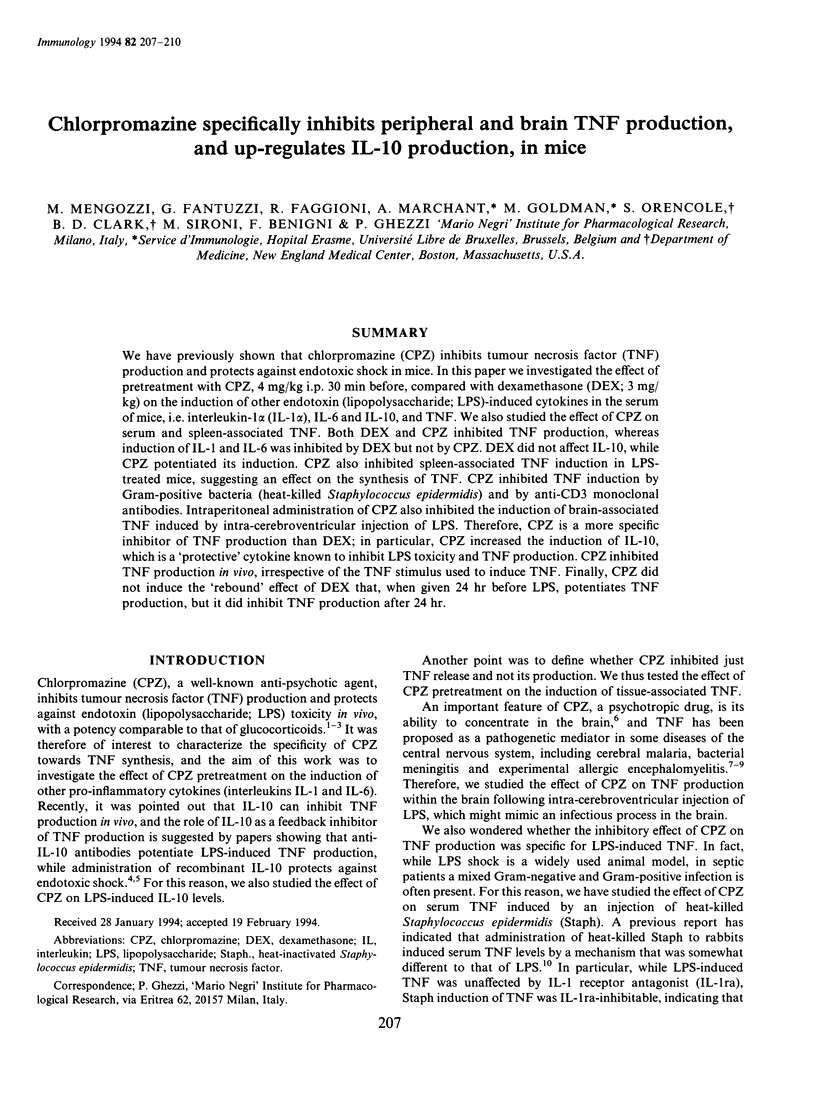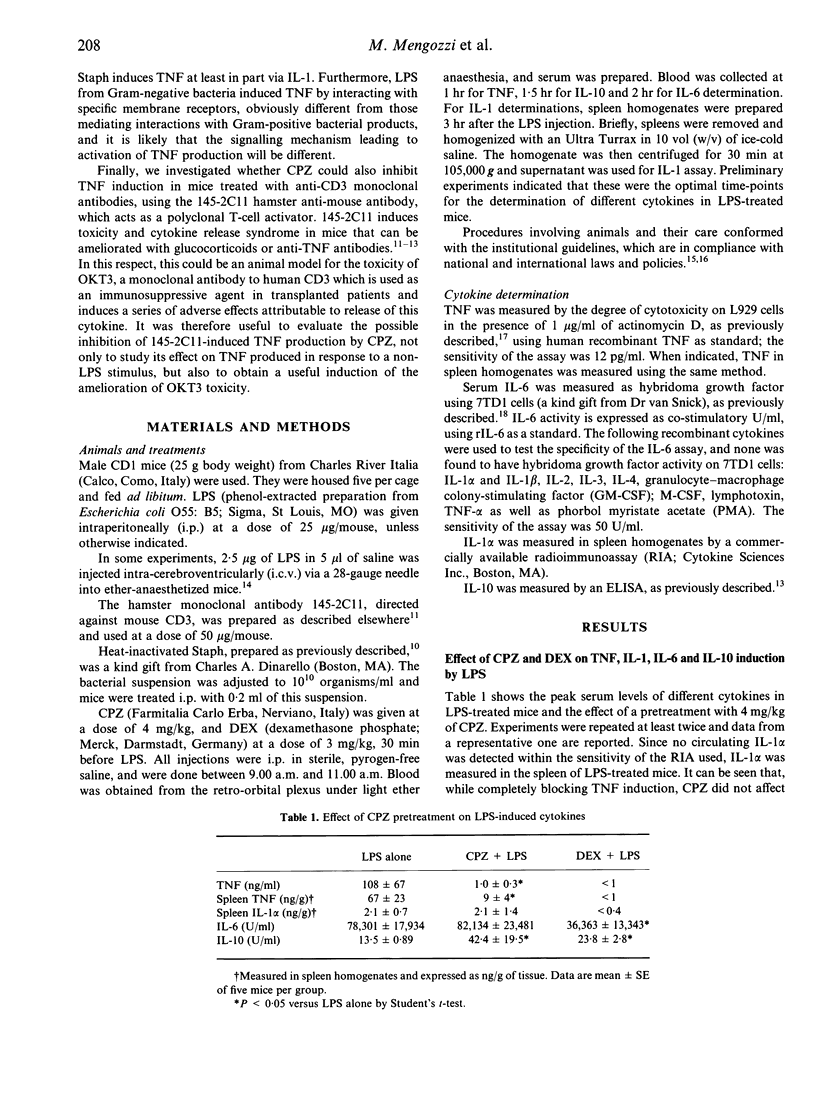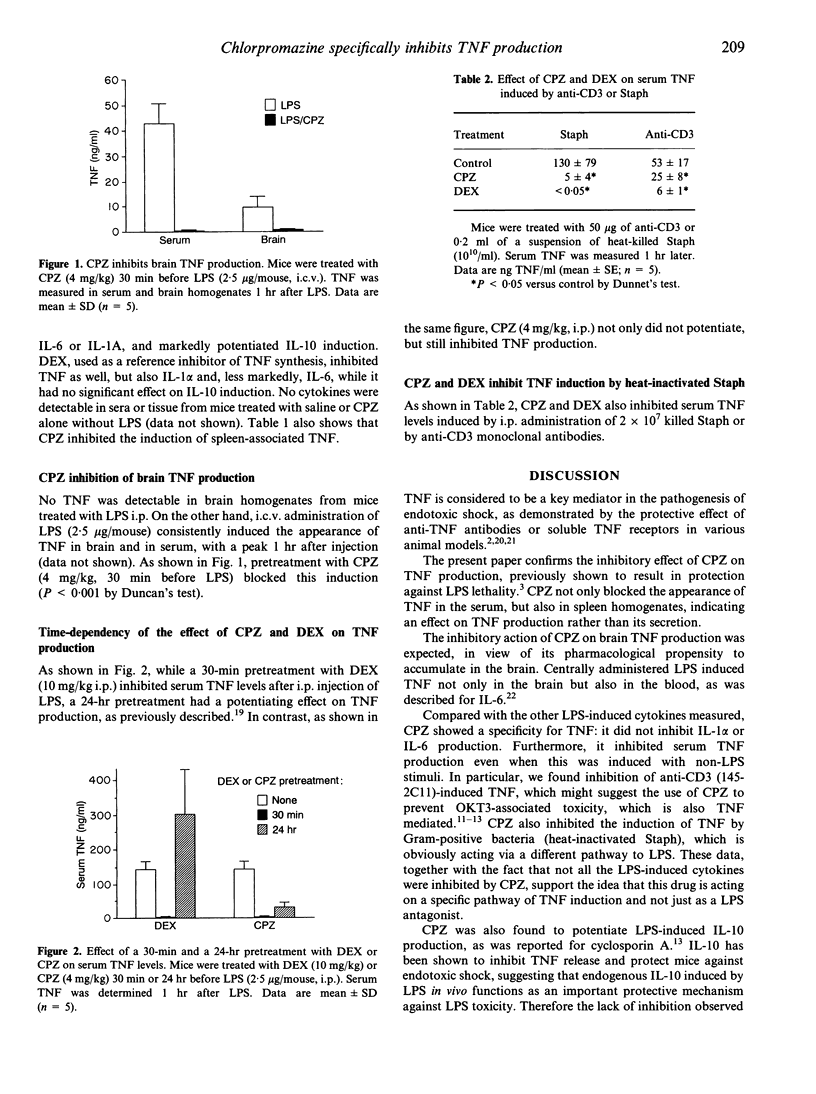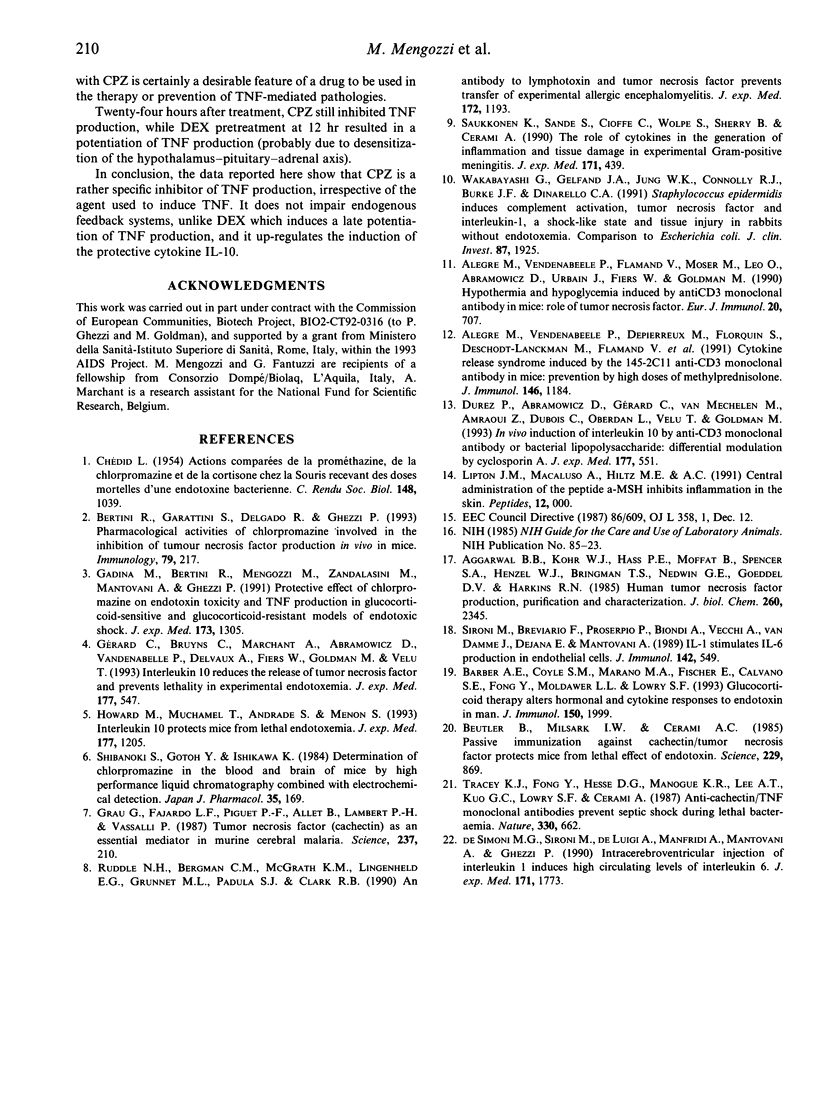Abstract
We have previously shown that chlorpromazine (CPZ) inhibits tumour necrosis factor (TNF) production and protects against endotoxic shock in mice. In this paper we investigated the effect of pretreatment with CPZ, 4 mg/kg i.p. 30 min before, compared with dexamethasone (DEX; 3 mg/kg) on the induction of other endotoxin (lipopolysaccharide; LPS)-induced cytokines in the serum of mice, i.e. interleukin-1 alpha (IL-1 alpha), IL-6 and IL-10, and TNF. We also studied the effect of CPZ on serum and spleen-associated TNF. Both DEX and CPZ inhibited TNF production, whereas induction of IL-1 and IL-6 was inhibited by DEX but not by CPZ. DEX did not affect IL-10, while CPZ potentiated its induction. CPZ also inhibited spleen-associated TNF induction in LPS-treated mice, suggesting an effect on the synthesis of TNF. CPZ inhibited TNF induction by Gram-positive bacteria (heat-killed Staphylococcus epidermidis) and by anti-CD3 monoclonal antibodies. Intraperitoneal administration of CPZ also inhibited the induction of brain-associated TNF induced by intra-cerebroventricular injection of LPS. Therefore, CPZ is a more specific inhibitor of TNF production than DEX; in particular, CPZ increased the induction of IL-10, which is a 'protective' cytokine known to inhibit LPS toxicity and TNF production. CPZ inhibited TNF production in vivo, irrespective of the TNF stimulus used to induce TNF. Finally, CPZ did not induce the 'rebound' effect of DEX that, when given 24 hr before LPS, potentiates TNF production, but it did inhibit TNF production after 24 hr.
Full text
PDF



Selected References
These references are in PubMed. This may not be the complete list of references from this article.
- Aggarwal B. B., Kohr W. J., Hass P. E., Moffat B., Spencer S. A., Henzel W. J., Bringman T. S., Nedwin G. E., Goeddel D. V., Harkins R. N. Human tumor necrosis factor. Production, purification, and characterization. J Biol Chem. 1985 Feb 25;260(4):2345–2354. [PubMed] [Google Scholar]
- Alegre M. L., Vandenabeele P., Depierreux M., Florquin S., Deschodt-Lanckman M., Flamand V., Moser M., Leo O., Urbain J., Fiers W. Cytokine release syndrome induced by the 145-2C11 anti-CD3 monoclonal antibody in mice: prevention by high doses of methylprednisolone. J Immunol. 1991 Feb 15;146(4):1184–1191. [PubMed] [Google Scholar]
- Alegre M., Vandenabeele P., Flamand V., Moser M., Leo O., Abramowicz D., Urbain J., Fiers W., Goldman M. Hypothermia and hypoglycemia induced by anti-CD3 monoclonal antibody in mice: role of tumor necrosis factor. Eur J Immunol. 1990 Mar;20(3):707–710. doi: 10.1002/eji.1830200337. [DOI] [PubMed] [Google Scholar]
- Barber A. E., Coyle S. M., Marano M. A., Fischer E., Calvano S. E., Fong Y., Moldawer L. L., Lowry S. F. Glucocorticoid therapy alters hormonal and cytokine responses to endotoxin in man. J Immunol. 1993 Mar 1;150(5):1999–2006. [PubMed] [Google Scholar]
- Bertini R., Garattini S., Delgado R., Ghezzi P. Pharmacological activities of chlorpromazine involved in the inhibition of tumour necrosis factor production in vivo in mice. Immunology. 1993 Jun;79(2):217–219. [PMC free article] [PubMed] [Google Scholar]
- Beutler B., Milsark I. W., Cerami A. C. Passive immunization against cachectin/tumor necrosis factor protects mice from lethal effect of endotoxin. Science. 1985 Aug 30;229(4716):869–871. doi: 10.1126/science.3895437. [DOI] [PubMed] [Google Scholar]
- CHEDID L. Actions comparées de la prométhazine, de la chlorpromazine et de la cortisone chez la souris recevant des doses mortelles d'une endotoxine bactérienne. C R Seances Soc Biol Fil. 1954 Jun;148(11-12):1039–1043. [PubMed] [Google Scholar]
- De Simoni M. G., Sironi M., De Luigi A., Manfridi A., Mantovani A., Ghezzi P. Intracerebroventricular injection of interleukin 1 induces high circulating levels of interleukin 6. J Exp Med. 1990 May 1;171(5):1773–1778. doi: 10.1084/jem.171.5.1773. [DOI] [PMC free article] [PubMed] [Google Scholar]
- Durez P., Abramowicz D., Gérard C., Van Mechelen M., Amraoui Z., Dubois C., Leo O., Velu T., Goldman M. In vivo induction of interleukin 10 by anti-CD3 monoclonal antibody or bacterial lipopolysaccharide: differential modulation by cyclosporin A. J Exp Med. 1993 Feb 1;177(2):551–555. doi: 10.1084/jem.177.2.551. [DOI] [PMC free article] [PubMed] [Google Scholar]
- Gadina M., Bertini R., Mengozzi M., Zandalasini M., Mantovani A., Ghezzi P. Protective effect of chlorpromazine on endotoxin toxicity and TNF production in glucocorticoid-sensitive and glucocorticoid-resistant models of endotoxic shock. J Exp Med. 1991 Jun 1;173(6):1305–1310. doi: 10.1084/jem.173.6.1305. [DOI] [PMC free article] [PubMed] [Google Scholar]
- Gérard C., Bruyns C., Marchant A., Abramowicz D., Vandenabeele P., Delvaux A., Fiers W., Goldman M., Velu T. Interleukin 10 reduces the release of tumor necrosis factor and prevents lethality in experimental endotoxemia. J Exp Med. 1993 Feb 1;177(2):547–550. doi: 10.1084/jem.177.2.547. [DOI] [PMC free article] [PubMed] [Google Scholar]
- Howard M., Muchamuel T., Andrade S., Menon S. Interleukin 10 protects mice from lethal endotoxemia. J Exp Med. 1993 Apr 1;177(4):1205–1208. doi: 10.1084/jem.177.4.1205. [DOI] [PMC free article] [PubMed] [Google Scholar]
- Ruddle N. H., Bergman C. M., McGrath K. M., Lingenheld E. G., Grunnet M. L., Padula S. J., Clark R. B. An antibody to lymphotoxin and tumor necrosis factor prevents transfer of experimental allergic encephalomyelitis. J Exp Med. 1990 Oct 1;172(4):1193–1200. doi: 10.1084/jem.172.4.1193. [DOI] [PMC free article] [PubMed] [Google Scholar]
- Saukkonen K., Sande S., Cioffe C., Wolpe S., Sherry B., Cerami A., Tuomanen E. The role of cytokines in the generation of inflammation and tissue damage in experimental gram-positive meningitis. J Exp Med. 1990 Feb 1;171(2):439–448. doi: 10.1084/jem.171.2.439. [DOI] [PMC free article] [PubMed] [Google Scholar]
- Shibanoki S., Gotoh Y., Ishikawa K. Determination of chlorpromazine in the blood and brain of mice by high performance liquid chromatography combined with electrochemical detection. Jpn J Pharmacol. 1984 Jun;35(2):169–174. doi: 10.1254/jjp.35.169. [DOI] [PubMed] [Google Scholar]
- Sironi M., Breviario F., Proserpio P., Biondi A., Vecchi A., Van Damme J., Dejana E., Mantovani A. IL-1 stimulates IL-6 production in endothelial cells. J Immunol. 1989 Jan 15;142(2):549–553. [PubMed] [Google Scholar]
- Tracey K. J., Fong Y., Hesse D. G., Manogue K. R., Lee A. T., Kuo G. C., Lowry S. F., Cerami A. Anti-cachectin/TNF monoclonal antibodies prevent septic shock during lethal bacteraemia. Nature. 1987 Dec 17;330(6149):662–664. doi: 10.1038/330662a0. [DOI] [PubMed] [Google Scholar]
- Wakabayashi G., Gelfand J. A., Jung W. K., Connolly R. J., Burke J. F., Dinarello C. A. Staphylococcus epidermidis induces complement activation, tumor necrosis factor and interleukin-1, a shock-like state and tissue injury in rabbits without endotoxemia. Comparison to Escherichia coli. J Clin Invest. 1991 Jun;87(6):1925–1935. doi: 10.1172/JCI115218. [DOI] [PMC free article] [PubMed] [Google Scholar]


